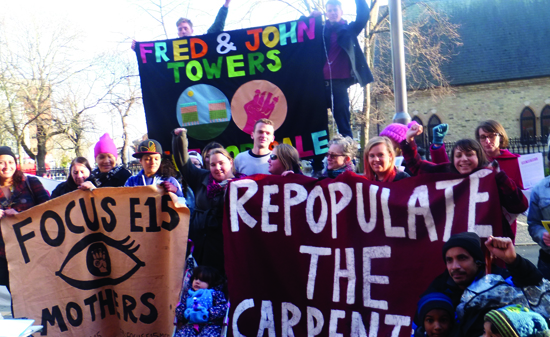
There are more than 93,000 children living in temporary accommodation in Britain, the vast majority of them in London. Government statistics published in June show, for the first quarter of 2015, homelessness rising across the country, with the crisis particularly acute in the capital.
- Between January and March 2015, 13,520 households were accepted as homeless by their local authorities – a rise of 8% on last year. Just under a third – 4,390 households – were in London.
- Just 7% were given a secure local authority or social landlord tenancy.
- The use of temporary accommodation to house homeless families has increased by 26% in the last five years, from 51,350 households in 2010 to nearly 65,000 in 2015.
- The use of bed and breakfast (B&B) type accommodation has more than doubled in that time in England; in London it has more than tripled, with one inner-city borough reporting a 1,500% increase in B&B use in just two years.
- 2,570 families with children were in temporary B&B/hostel accommodation as at 31 March 2015 – an increase of 35% on the previous year. Of these 36% had been in B&Bs for more than six weeks – which is illegal.
- More than a quarter (26%) of families in temporary accommodation had been housed outside their home borough – a rise of 30% since 2014 – with 93% of these families moved out of London boroughs.
- Just over half the households accepted as homeless by local authorities were single parents, the vast majority women. A third of those accepted were from black and minority ethnic backgrounds.
These figures measure only those the local authority has a legal duty to rehouse. 51% of those applying for housing assistance between January and March were turned down, meaning the real figure of Britain’s hidden homeless is far, far higher.
The most frequent cause of homelessness was the ending of an assured shorthold tenancy with a private landlord. This is up 27% on the same quarter in 2014. The London figure was 39%. In 2014, evictions reached a record high in England and Wales, at 115 a day. But figures for the first three months of this year were outstripping that – even before the introduction of the overall cap on benefits in April (see p2). Meanwhile average rent for a two-bedroom flat in Greater London is now £2,216 per month (The Guardian 1 May 2015). Shelter estimates that by 2017, only 6% of England will be affordable for those on housing benefit.
Social cleansing: London’s council estates up for grabs
In June, the new minister for Communities and Development, Brandon Lewis, told an elite conference of London property developers in Mayfair that it was time for the ‘demolition and redevelopment of council estates across London’ to ‘boost the supply of new homes’ on ‘valuable brownfield land’. The suggestion closely echoed that made in May by Labour’s Lord Adonis and the previous Conservative minister for communities Eric Pickles (see FRFI 245) and is now clearly government policy. Lewis – himself a private landlord, like a quarter of Conservative MPs – complained that inner London boroughs now house fewer people than in the pre-war years due to ‘lower density’ housing. Yes – because from the 1930s onwards there were progressive moves to clear crowded, unsafe and unsanitary private housing and build spacious, decent homes for the working class amidst children’s play parks and communal gardens. Lewis and his ilk would drive the working class back to the slums, while building more luxury flats for his buy-to-let landlord chums and wealthy overseas investors. The poorest sections of the working class are already being crammed into unsafe, shoddy spaces unfit for human habitation. More than 18% of all homes in London are overcrowded – 43% in the social housing sector.
A city of glittering spires
Meanwhile £150 million is being put aside to boost the development of more ‘quality homes in areas of high demand’ – Stratford’s Olympic Village, Westminster, Southwark’s Newington Butts and Elephant Park. None of these will be affordable for the majority of working class people. Developers continue to use notorious ‘viability studies’ to argue down the misleadingly named ‘affordable’ (80% of market rent) housing they need to provide, preferring to hand over money to the local council to build those homes elsewhere. The most recent example is Neo Bankside in Southwark – a set of high-rise glass and steel tubes on the South Bank of the Thames designed by the architect Richard Rogers which has just been shortlisted for a prestigious award (The Guardian, 21 July, 2015). Its penthouses are on sale for £22m. Yet, in an example of what journalist Ollie Wainwright describes as ‘a story of developers relentlessly trying to reduce their obligations, and a council all too willing to let them’, developers Native Land and Grosvenor successfully first reduced the number of ‘affordable’ homes from 40% to 27.5% of total build – and then insisted these should be built in some less desirable part of the borough. Southwark Council promptly handed over a council-run children’s home and nursery to build on. Just 94 ‘affordable’ units – 62 at council rents – have been built, 38 fewer than required, and the children’s facilities have not been replaced. This ‘stratospherically priced non-dom accom’, wrote Catherine Slessor, former editor of the Architectural Review, is ‘depressingly emblematic of how London is turning into a coarser version of Paris with an unaffordable core and atomised banlieues’.
Cat Wiener
FRFI 246 August/September2015




